

Welcome to Explore Montana Outdoors, where the wilderness beckons and loyal companions wag their tails in anticipation. Hiking with your furry best friend enriches the experience, blending the joy of nature with the bond of companionship.
In this article, we’ll discuss the best practices and trail-tested tips for ensuring a safe and exhilarating adventure for you and your canine companion. From paw protection to hydration hacks, let’s learn about those tail-wagging treks under the Big Sky!
Embarking on hiking adventures with your four-legged friend can enrich the experience of exploring the great outdoors. However, ensuring your trail dog is fully equipped is crucial for a safe and enjoyable trek.
It’s vital to assemble dog gear tailored to your pet’s needs, including a sturdy leash and harness that provide control without restricting movement.
Always pack a collapsible bowl and ample water to keep your furry pal hydrated—dog-safe practices are non-negotiable.
The best hikes with dogs incorporate trails with access to shade and water, minimizing the risk of overheating. Remember, trail-friendly snacks are available for you and your pet to sustain energy throughout your journey.
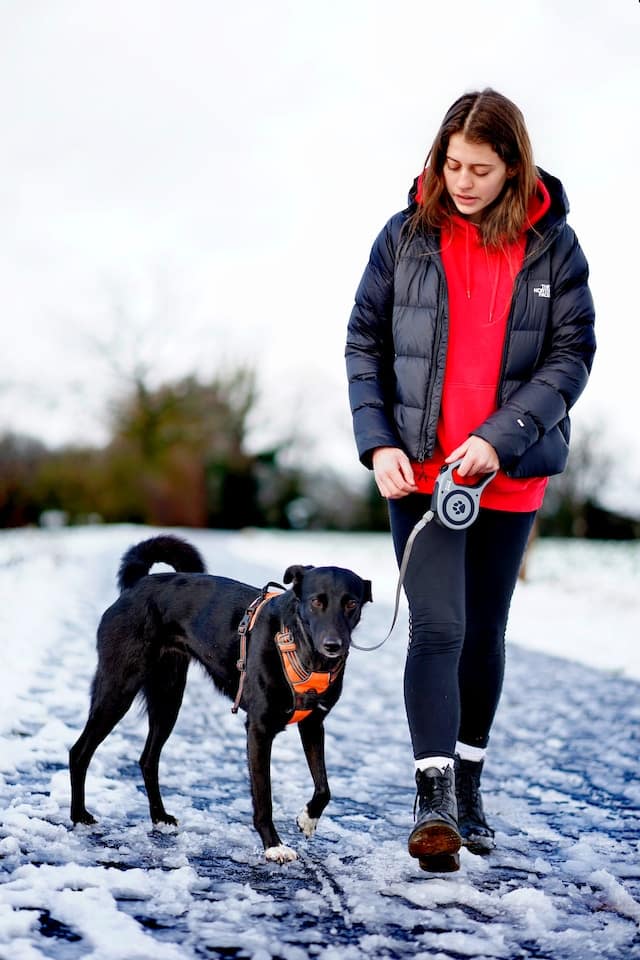
Moreover, paw protection should be considered when traversing rugged terrain to shield those delicate paws from sharp rocks and extreme temperatures.
Reflective gear or a light-up collar ensures visibility as the sun sets, keeping you and your pet safe in lower lighting.
Ensure your dog’s ID tags are up-to-date, and add a location tracker for peace of mind. Lastly, a first-aid kit tailored for pets can be handy for addressing minor injuries quickly.
These preparations will ensure hiking with dogs is not only fun but also stress-free, opening the door to countless adventures with your loyal companion by your side.
| Product Category | Specific Item | Purpose |
|---|---|---|
| Harness and Leash | Sturdy dog harness with a handle | Provides control in challenging environments and helps over obstacles. |
| High-quality leash | Offers durability and some freedom of movement. | |
| Hydration Equipment | Collapsible water bowl | Essential for hydration on the go. |
| Ample fresh water supply | Keeps your dog hydrated throughout the hike. | |
| Paw Protection | Protective dog boots or paw wax | Protects paws from sharp rocks, hot ground, and rough terrain. |
| Visibility Gear | Reflective gear or light-up collar | Increases your dog’s visibility in lower light conditions. |
| Identification | Up-to-date ID tags and location tracker | Helps in locating your dog if they get lost. |
| Nutrition | Trail-friendly snacks | Maintains energy levels for both you and your dog during the hike. |
| Health and Safety | First aid kit tailored for pets | For addressing minor injuries and health needs that may arise during the hike. |
| Cooling Gear | Cooling bandana | Helps to manage your dog’s temperature and prevent overheating. |
| Insect Protection | Vet-recommended insect repellent | Protects against ticks, mosquitoes, and other pests. |
Embarking on a trek through nature can be an exhilarating experience, and it’s no surprise many adventure enthusiasts seek tips for hiking with their four-legged companions.
The recommended trail equipment is essential for ensuring your trail dog’s safety and enjoyment.
A sturdy dog harness with a handle is a good choice for maintaining control in challenging environments and aiding your pup over obstacles. Next, consider a high-quality leash that allows for some freedom and provides durability and reliability in various terrains.
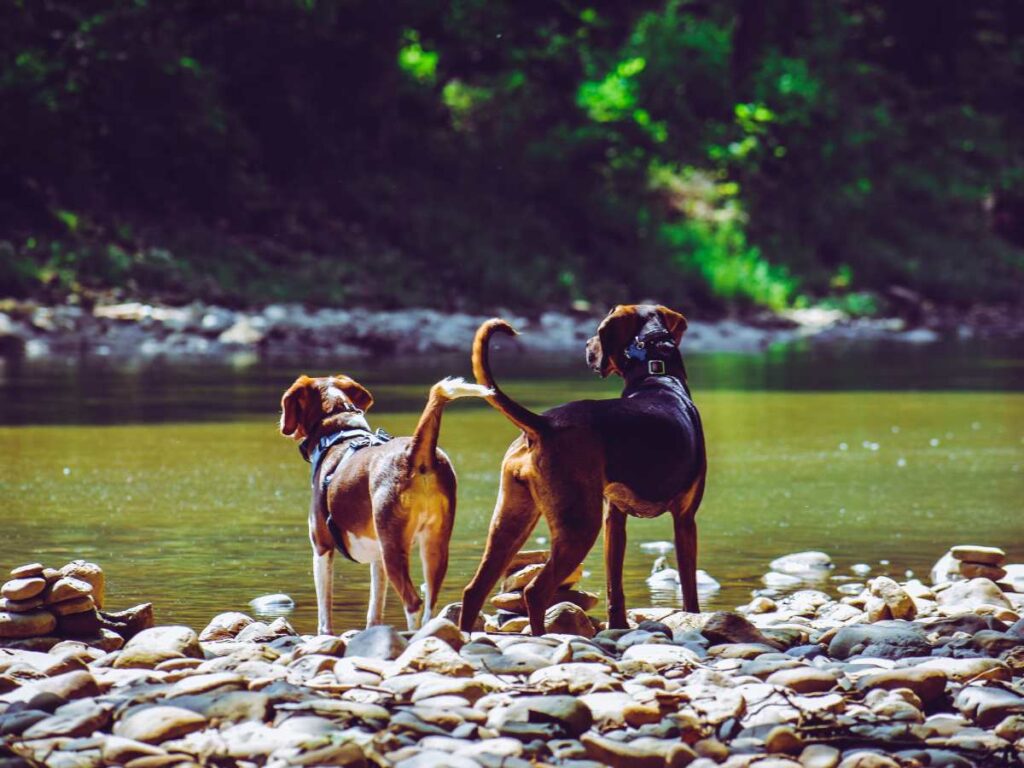
Collapsible bowls are lightweight and indispensable for hydration and nutrition on a backpacking journey. They’ll ensure your dog stays hydrated and energized during your adventures.
Also, don’t overlook the importance of a dog gear pack; having your dog carry its supplies can be remarkably helpful as long as the weight is distributed correctly and not excessive.
Proper footwear for your trail dog might sound peculiar, but protective dog boots prevent injuries to their paws in rugged conditions.
Lastly, a first aid kit tailored for dogs is a must-have. Including tick tweezers and bandages ensures you’re prepared for any minor injuries your dog could encounter.
Always remember that your furry friend’s safety and comfort should be a top priority, and equipping them with the right gear will pave the way for a memorable experience with Explore Montana Outdoors.
Water safety must be considered when hiking with your furry companion. Dogs exert considerable energy on the trails, making hydration as critical for them as it is for us.
To ensure your pet stays adequately hydrated, always carry ample fresh water and a collapsible bowl, which is essential for dog hiking. Watch for signs of dehydration in your dog, such as lethargy, dry gums, and excessive drooling.
If you notice these symptoms, it’s time to take a water break.
Moreover, while selecting the route for your hike, opt for trails with natural water sources that are dog-safe. Always treat water before letting your pet drink to prevent waterborne illnesses. Establishing a hydration routine is also among the paramount tips for a successful outdoor adventure.
Offer water to your dog at regular intervals, as they might only sometimes signal their thirst. And remember, never assume that a wet nose means a hydrated pet – that’s a myth.
By incorporating these hydration tips into your outdoor journey, you’re taking steps to ensure your dog’s well-being and setting the stage for many more enjoyable and safe hikes together.

Heatstroke in dogs is defined as a nonpyrogenic increased body temperature above 104°F (40°C), with a spectrum of systemic signs. The ability to rapidly recognize and begin treatment of heatstroke is vital to maximize the chances of saving the animal’s life. (source Todays Veterinary Practices)
Dog health should always be a top priority when you’re out on the trail. One of the most severe risks during a hike is heatstroke. To keep your dog safe from the heat, always practice proactive measures.
A vital aspect of this is maintaining water safety by ensuring your pet has constant access to fresh, cool water—hydration is as critical for them as it is for us.
Look for signs of overheating, such as excessive panting, drooling, or lethargy.
If you notice any of these, you must find shade and give your dog a break.
Packing a lightweight, collapsible bowl will encourage your pet to drink regularly, and remember to give them small amounts of water at frequent intervals.
In addition to hydration, consider wetting a bandana in cool water and draping it over your dog’s neck to relieve the heat.
Moreover, it is helpful to plan your hikes during cooler parts of the day—early morning or late afternoon.
Always choose a trail that offers shade and potentially even a stream or lake where your pet can swim, drastically reducing the risk of heatstroke.
By understanding and prioritizing your pet’s comfort and safety, you can ensure you and your four-legged friend enjoy a healthy adventure in nature.
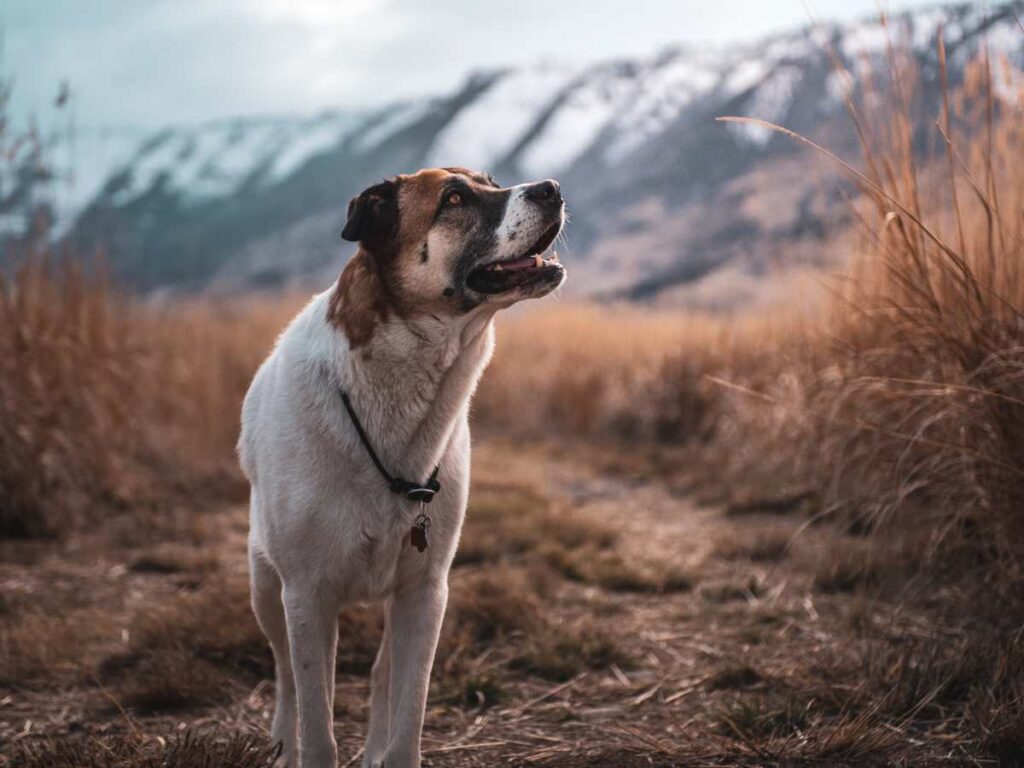
Embarking on a hike with your four-legged friend is an adventure that requires mindfulness of both hiking safety and trail etiquette. Ensuring a safe hike for you, your dog, and your fellow trail enthusiasts involves a keen awareness of the environment and the needs of your canine companion.
Prioritize your dog’s well-being by following dog-friendly trails that welcome your pup with open arms. Respect for nature and others is paramount; everyone’s there to enjoy the beauty and serenity the outdoors offers.
Maintaining control of your dog at all times is essential, keeping it leashed where required to prevent unnecessary encounters with wildlife or other hikers. Familiarize yourself with the trail’s rules and prepare your dog for the journey by gradually increasing its stamina for longer trails.
Remember, every hike is a chance to instill good manners in your dog; simple acts like yielding to oncoming hikers and ensuring your dog doesn’t stray off the designated paths can go a long way in upholding the peace and beauty of nature.
Lastly, always leave no trace. This means carrying out whatever you bring in, including your dog’s waste.
A responsible hiker cherishes the present experience and preserves the trail for future adventures. At Explore Montana Outdoors, we champion these practices, knowing that safety, respect, and preparedness are vital to creating joyful and memorable hiking experiences with your faithful companion by your side.
Embarking on a hike with your four-legged friend requires more than simply hitting the trail; it’s about incorporating best practices that ensure a fun and responsible experience for all. Hiking trails offer an escape into nature, but following specific guidelines is essential as you prepare to hike with your pup.
Always ensure the trails are dog-friendly, as some areas have specific pet rules. Once you’ve confirmed your furry companion can join, keep your dog on a leash to protect wildlife and maintain respect for other hikers.
Cleaning up after your pet is a must, as is being mindful of their interactions with others, both humans and animals. Adhering to these guidelines fosters a safe and enjoyable environment for everyone.
Remember, it’s about our adventure and preserving the natural beauty of our hiking spots for others to enjoy. By following these responsible practices, we showcase our commitment to the outdoor community and ensure our beloved trails remain welcoming and accessible for all dog lovers and their faithful hiking buddies.

Exploring the great outdoors can be thrilling, but when you’re hitting the best hikes with dogs, it’s crucial to prioritize your trail dog’s safety.
Wildlife encounters are a part of nature’s package, yet with thoughtful preparation, you can ensure these interactions don’t harm your furry friend.
First, keep your dog’s leash snug and secure; it’s the first defense in keeping the dog safe. Understand the signs of wildlife presence and steer clear, using your vigilance to protect your dog on the trails.
A well-trained dog hiking alongside you is less likely to chase after creatures, reducing the risk of potential danger. Educating yourself on the local wildlife you might encounter is also wise.
Knowing what creatures lurk in the shadows will prepare you for calm, collected reactions, whether it’s a serene forest or a rugged mountain path.
Carrying protection like a bear spray can be a safety net, but knowing when and how to use it is paramount.
And remember, your dog’s well-being continues with wildlife; check their paws frequently for cuts or thorns, and always keep them hydrated on the trails.
Creating a memorable adventure with your dog in the incredible Montana landscapes means embracing responsible practices for a dog-friendly hike.
Combat the unexpected with knowledge and gear, and you’ll craft an experience that’s both safe and exhilarating – for you and your four-legged explorer. Rich content results: Image
While soaking up the beauty of the trail with your furry companion, it’s crucial to be aware of potential snake and insect threats that could impact dog health.
As you’re walking, keep your eyes peeled for signs of snakes basking in the sun or hiding in the underbrush.
Keeping your dog on a leash, especially in areas known for snake activity, is essential to prevent unexpected encounters. If there’s an unfortunate run-in, staying calm and seeking immediate veterinary care can make all the difference for your dog’s well-being.
Insect threats like ticks and mosquitoes also risk humans and canines, potentially transmitting diseases.
Always apply a vet-recommended insect repellant designed for dogs before hitting the trail, and once your hike concludes, conduct a thorough check for ticks and other pests.
For added safety, snake and bug venom vaccines are available for dogs, protecting against these unwanted trail hazards.
Your dog’s health relies on your preparedness and vigilance; therefore, educate yourself on the wildlife native to the trails you explore.
With knowledge and appropriate precautions, you can ensure a safe and enjoyable outdoor adventure for you and your loyal companion.
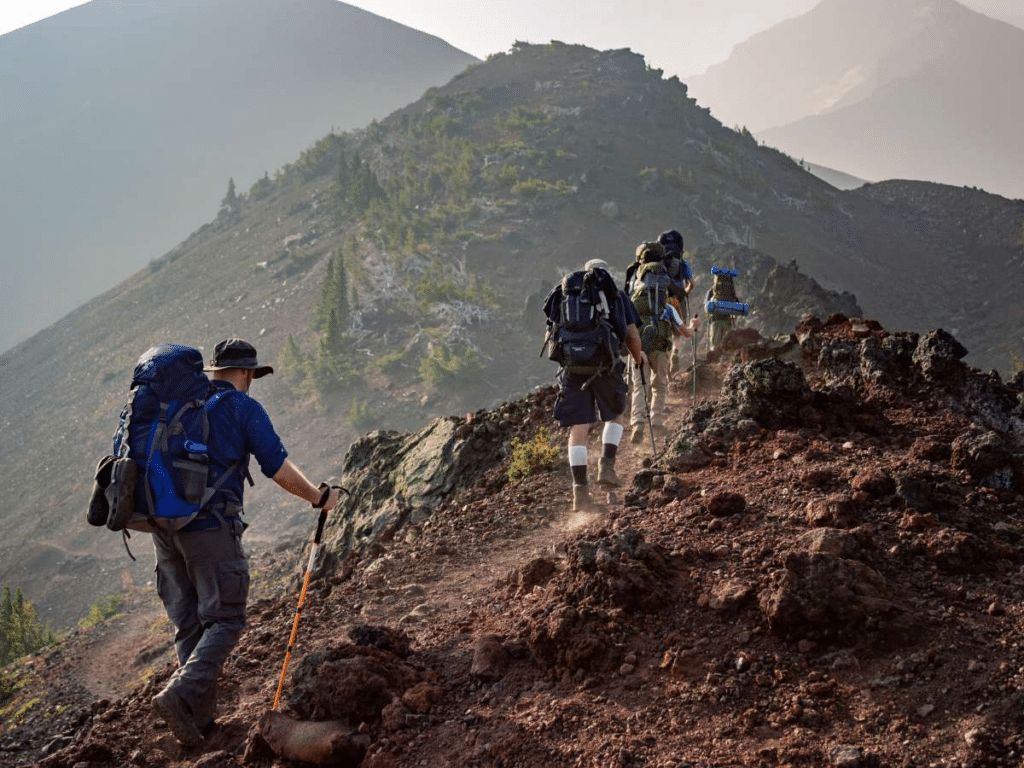
Embarking on a hiking trail adventure with your pup can be incredibly rewarding, but it’s essential to prioritize the safety of your four-legged companion.
To hike safely across varied terrains, you’ll need to be well-prepared and mindful of your dog’s safety and comfort.
Top considerations include familiarizing yourself with the hiking trails beforehand; this can’t be stressed enough. Ensure the trail aligns with your dog’s abilities, and check if it is explicitly dog-safe.
Dog-friendly hiking trails often have amenities such as waste stations and water access points, which are integral to a safe hike.
Maintaining your dog’s safety on the trails becomes paramount as terrain changes. Equip your dog with a reliable harness and leash suitable for the outdoors, and keep a close eye on potential hazards.
Watch out for heat conditions, as dogs are susceptible to heatstroke, and always carry ample water to prevent dehydration. Responsibly managing your dog means anticipating encounters with local wildlife, which could pose threats, just as it’s crucial to be aware of the risks from snakes and insects.
Remember, a safe hike begins with preparation, awareness, and respect for the trails you’re exploring with your furry friend.
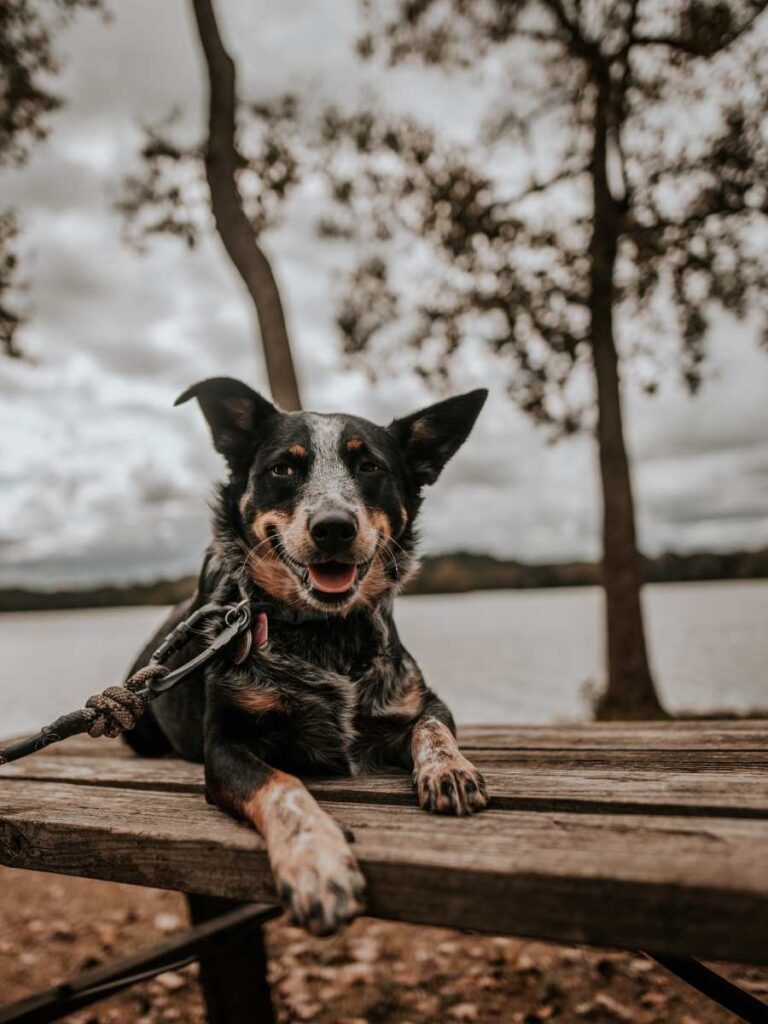
Navigating Rocky Trails and Streams with Your Dog
When your trail dog joins you on a hiking adventure, mastering the skills for navigating rocky trails and crossing streams is essential for your safety and your furry friend’s well-being. It starts with preparation, ensuring you’ve selected a suitable path that accommodates your dog’s ability and confidence levels.
On rocky trails, maintain a steady pace, allowing your dog to find their footing—patience is key. It’s also critical to watch your dog’s paws; rough terrain can be unforgiving, and booties might be a wise investment for these conditions.
Approaching streams requires different considerations—ensure the current isn’t too strong for your trail companion, and always check the depth before allowing your dog to plunge in. It’s usually best to lead by example, showing your dog the safest points to enter and exit the water.
A hike isn’t just about navigating but also about enjoying the experience. Encourage your dog at intervals, turning these challenging parts of the trail into a bonding experience.
Always remember, the goal is a fun and secure hike for both of you, so keep your outings within what you both can comfortably tackle. By following these tips and best practices, you’ll make memories that will last a lifetime on the trails, ensuring every hike with your dog is an Explore Montana Outdoors moment worth cherishing.
As hiking enthusiasts, we understand the thrill of exploring trails with our four-legged friends, but ensuring their paws are well-protected is crucial. The recommended dog paw protection ranges from boots to natural balms designed to shield their paws from harsh terrains.
Dogs’ paws are hardy, yet they’re not impervious to the rough landscapes and varying temperatures we encounter on our adventures. Investing in high-quality dog gear for their paws isn’t just a good idea; it’s essential.
Proper dog gear includes breathable, durable boots or protective socks that offer a barrier against sharp rocks, thorny underbrush, and scorching paths. A good fit is vital to prevent discomfort or loss of gear as your dog explores.
Enthusiasts should always have their dog’s paws measured accurately before purchasing boots to ensure a snug and secure fit. Additionally, consider the specific paw protection your dog may need when hiking across different terrains.
For example, during winter hikes, look for boots that provide insulation against the cold, and during hot summer treks, opt for boots that can defend against hot surfaces.
Beyond boots, paw waxes and balms can be an excellent complement to physical dog paw protection. These products can moisturize and heal cracked pads, creating an extra layer of defense.
It’s important to remember this aspect, as well-hydrated paws are less prone to injuries. By selecting the *recommended* protection and embracing these tips, you’ll ensure your dog’s paws remain safe, letting you both enjoy the great outdoors with peace of mind.
Embarking on a hiking adventure with your trail dog sparks joy but warrants vigilance, especially when handling potential injuries. Acquaint yourself with first aid basics to ensure you and your pet are trail-ready in emergencies.
While it’s a dog owner’s top priority to prevent injuries, unexpected situations can occur, making it essential to know how to handle these incidents immediately and effectively. Every dog hiking kit should include a pet-specific first aid kit tailored for handling cuts, splinters, or more severe injuries your dog might face on the trail.
Should your dog sustain an injury, remain calm; a soothed pet tends to cooperate better, allowing you to assess and manage the situation. It’s vital to have a practical understanding of common injuries pets encounter while hiking, from pad abrasions to insect bites.
Injuries can vary, and knowing how to treat each one properly can make all the difference in your dog’s comfort and safety.
Additionally, educate yourself on the nearest veterinary services available during your hikes. If an injury is beyond your field capabilities, immediate and professional care is the best recourse.
Being prepared and knowledgeable ensures that every hike with your dog remains a beautiful escapade marked by safety and enjoyment. Remember, a well-prepared owner is a dog’s best ally on any trail.
Embarking on a hike with your furry companion can be a rewarding experience, but it’s essential to be prepared for any mishaps. Knowing the best practices for treating common hiking injuries in your dog ensures their safety and well-being.
A dog’s adventurous spirit and curiosity can sometimes lead to injuries, and as their trusted human, it’s your responsibility to respond effectively. If your dog gets a cut or scrape, it’s best to clean the wound immediately with antiseptic and apply a bandage if needed.
Sprains or strains require rest and potentially a cold compress to minimize swelling. Always carry a canine-specific first aid kit while hiking, including items like gauze, tweezers, and vet-approved pain relievers.
Remember that prevention is just as important as treatment for those with an active pup. Remember to give your dog thorough warm-ups before hitting the trails and ensure they’re in good physical condition to tackle the trek.
Additionally, be mindful of your dog’s limits and watch for signs of fatigue or distress. Ultimately, safety should always come first.
Whether exploring the vast landscapes of Explore Montana Outdoors or your local hillside, maintaining a secure and hazard-free experience is paramount. By adhering to these pointers and fostering a preventive mindset, you’ll be equipped to handle common injuries that might occur, keeping your tail-wagging trail partner happy and healthy throughout all your outdoor escapades.
More Research On Hiking With Your Pet:


The Montana Style is a participant in the Amazon Services LLC Associates Program, an affiliate advertising program designed to provide a means for sites to earn advertising fees by advertising and linking to Amazon.com
To learn more about Trevor Riggs, please visit our About page.
The Montana Style is a participant in the Amazon Services LLC Associates Program, an affiliate advertising program designed to provide a means for sites to earn advertising fees by advertising and linking to Amazon.com